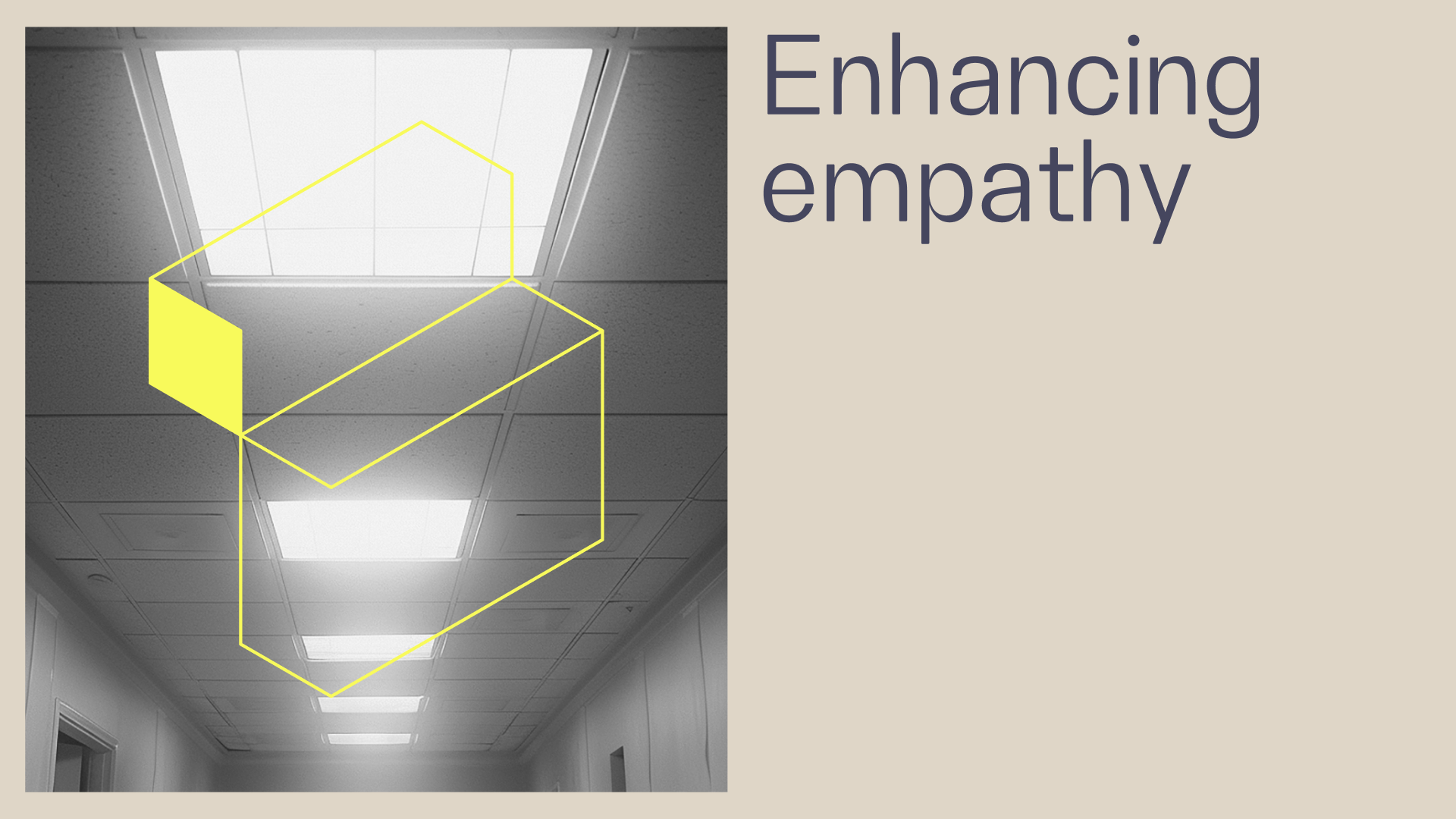AI is already reshaping healthcare

AI is broadening how we derive meaning from data, offering new perspectives that were previously inaccessible to most.
It’s helping us better understand fundamental biological processes like protein folding, and bringing the open source movement to human gene editing. But as designers and technologists, our focus extends beyond the data to consider how AI can impact the human experience. We are committed to harnessing AI’s potential to not only improve processes, but also to enhance lives.
William Gibson once said, "The future is already here–it's just not evenly distributed." This is particularly true in healthcare, where the adoption and impact of AI varies widely. In some health systems, experimentation with AI is already having an effect on patient and provider experiences. In others, it's primarily a tool to cut back office costs. And in far too many, it’s nowhere at all. Our goal is to smooth this distribution a bit, uncovering the benefits of AI that can address the core human need to be seen, understood, and cared for. Here are some key applications that could move that effort forward.

Close observation
AI’s ability to be omnipresent, listening, and interpreting is one of its most promising capabilities. Tools like Abridge Inside are transforming patient interactions by summarizing provider-patient conversations and generating care plans in real-time, directly integrating them into medical records. This kind of ambient documentation is changing how both providers and patients relate to care visits by reducing the administrative burden on providers and improving patient understanding of their care plans with clearer and more tailored visit summaries.
In skilled nursing facilities, where high patient-to-staff ratios are common, Care.ai’s Smart Care Facility Platform uses ambient intelligent sensors to monitor patients closely, reducing the workload on healthcare providers. This technology is a step toward integrating AI into clinical settings, allowing for more efficient and personalized care, and making sure that no patients fall through the cracks.
Early combinations of AI and robotics have pushed the possibilities of who—or what—might be able to deliver care. During the COVID-19 pandemic, Boston Dynamics, MIT, and Brigham and Women’s Hospital used a Spot robot equipped with sensors to remotely monitor patient vitals, with the goal of reducing healthcare worker exposure to COVID-19.
We’ve seen similar innovations in more everyday settings, hinting at what might happen when these kinds of ideas scale. At the MIT Media Lab, the Fluid Interfaces group has developed a conversational memory aid designed to assist with daily tasks. This device, which works on commercially-available hardware, offers a glimpse into the future of AI-driven, unobtrusive memory augmentation. It’s a small but powerful example of how AI could be used to support cognitive functions in everyday life, improving everyone’s ability to navigate logistics and to make more meaningful social connections.
At IDEO, we’ve experimented with similar AI in more informal settings. Our colleague Danny DeRuntz developed a Slackbot that helps users catch up on conversations by summarizing messages and even creating whimsical “sauces” that capture the week’s vibe. While this may seem light-hearted, it underscores the potential for AI to bridge gaps in communication and reduce the cognitive load in professional environments.

Hyper dynamic tools
Healthcare has long been plagued by poorly-implemented and difficult-to-use technology, particularly when it comes to electronic health records (EHRs). AI is now driving the development of hyper-dynamic tools that can adapt to the needs of individual patients and providers, from device technicians to specialized neurologists. Epic, the premier EHR provider, is currently trialing more than 60 AI-driven use cases across health systems, with the ambition to significantly improve the user experience by making EHRs more responsive and less cumbersome. Of course, efforts like this to significantly decrease the time burden of using EHRs have been tried before, with very mixed success.
Startups are also using AI to address healthcare’s continued reliance on outdated technology. Tennr, for example, is using AI to interpret and send faxes—which are still used surprisingly often in healthcare—while Hippocratic AI is automating workflow calls like discharging patients, remote monitoring of health conditions, and pre-procedure preparation that would otherwise require human intervention. These innovations suggest that new technology may even be able to solve some of the problems created by older ones.
Beyond healthcare, we’ve seen AI used in similar ways to tackle everyday tasks. Google’s Duplex AI is a prime example, capable of autonomously booking appointments by making phone calls that sound eerily human. This kind of task-specific AI reflects the adaptability we hope to see in healthcare tools, enabling them to meet the unique needs of each user. Importantly, this use case is from 2018, long before our current and much more capable crop of AI tools came to market. Imagine Duplex being applied for appointment scheduling, medical supply chain tracking, and even up-to-date clinical fact-checking. We are likely close to a future of customizable, or potentially even fully-DIY tools that can take on some of our daily health tasks.

Enhancing empathy
One of AI’s most human, and therefore most controversial, potentials lies in enhancing empathy within healthcare. Studies have shown that AI tools, like ChatGPT, can often deliver more compassionate responses than human physicians. This raises important questions about how scalable machine empathy could be and what it means for patient care.
In simulation environments, AI is being used to model entire hospital systems, where each staff member and patient is represented by an AI agent. These simulations can not only improve AI performance, but also reveal the emotional pressures of a workflow and the impact of misaligned incentives, offering new insights into how we design and manage healthcare systems.
Cultural projects have also explored the concept of AI-driven empathy. For example, Laurie Anderson worked with the University of Adelaide’s Australian Institute for Machine Learning to create a Lou Reed AI that replicates her late husband’s voice and style. While acknowledging that this bot is not her husband, she finds value in the creative collaboration she gets from writing with it. Although this might seem like its applications are a long way from healthcare, this project highlights AI’s potential to engage human empathy through emulating personality and style—an area that could have profound implications for patient interactions in the future.
.png)
Escalating negotiations
The automation of prior authorization processes is a double-edged sword. AI can streamline the filing process, making it faster and more efficient, but speed can come at a cost. The recent revelations about Cigna's use of AI to deny claims in mere seconds is a concrete example of how AI can be used to prioritize efficiency over compassion, leading to significant concerns about denial of patient care.
Similar dynamics have played out in consumer markets. Amazon’s Hands Off the Wheel program, which automated pricing negotiations between Amazon and third party sellers, led to significant changes within the company, including layoffs and a restructuring of teams. AI-driven automation can fundamentally alter business processes, a trend that could similarly impact healthcare as AI continues to evolve.
AI is even transforming the landscape in businesses like telemarketing. The Jolly Roger Telephone Co. uses AI to keep telemarketers on the line, wasting their time and protecting consumers from unwanted calls. This creative use of AI highlights the ethical considerations that come with automation—questions that are equally relevant in the high-stakes world of healthcare.

Custom weirdness
Personalized medicine has long been a buzzword, but AI is pushing the boundaries of what personalization can truly mean. Gene therapies, for example, have seen breakthroughs with 36 FDA-approved treatments and hundreds more in the pipeline. AI’s ability to better map our bodies and molecules promises even more tailored treatments, but it also raises important questions about safety, responsibility, and the ethics of such deeply-personalized interventions.
In mental health, companies like Tripp VR are using AI to create hyper-personalized, generative meditation experiences. While this might not appeal to everyone, it demonstrates the breadth of care opportunities that AI is opening up, particularly in areas like anxiety and chronic pain management.
Beyond the clinic, platforms like Character.ai, where users create and interact with custom AI personalities, highlight how quickly consumers are adopting AI-driven personalization. This trend could spill over into healthcare, where patients might soon expect—and demand—highly-personalized AI presenting care solutions.
At the fringes of this trend are biohacking enthusiasts who are pushing the limits of personalized health. Some are experimenting with gene-edited bacteria that produce alcohol instead of lactic acid (preventing cavities), or antibiotics that kill competing oral bacteria. While these innovations are not yet FDA-approved, they signal a potential Cambrian explosion of personalized health interventions driven by consumer demand.
The road ahead
AI has the potential to be a true collaborator in healthcare, helping practitioners see patterns across modalities that are not visible to individual people. It is our responsibility as designers, technologists, and healthcare professionals to ensure that AI tools are developed with the needs and perspectives of all stakeholders in mind.
As we move forward, we must embrace experimentation and collaboration, ensuring that AI not only enhances healthcare efficiency but also contributes to a more humane and empathetic system. The future of AI in healthcare is promising, but it requires us to actively engage with these tools and guide their development to serve the greater good.
For us, that means leaning into human-centered design, and putting people and their needs at the center of the process. That’s how we work with our clients to build desirable and responsible futures, and to understand how our technology choices will impact participants in the health system. It’s also why we believe so strongly in co-design, working alongside the folks we’re building new health tools for, as we did with teenagers in California to build Soluna, a mental wellbeing app for the state’s young people, which we made in partnership with Kooth. Because when we’re building health tools with emerging technologies like AI, it’s critical that we go beyond doing no harm, and build the right solutions for patients and providers.
(This piece was adapted from a talk delivered at the American Medical Informatics Association® Clinical Informatics conference.)
Words and art


Subscribe

.svg)







